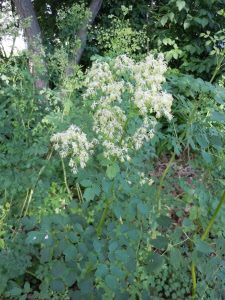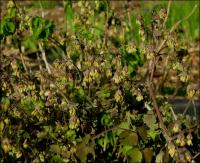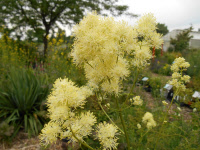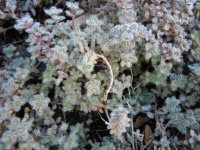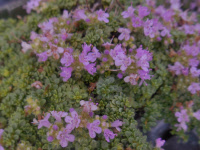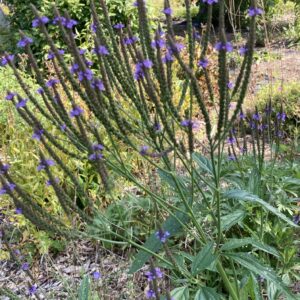Deer Resistant Plants
Showing 145–152 of 155 results
-
Thalictrum coriaceum Maid of the Mist Z 5-7
Broad panicle of white flowers with maroon-colored filaments and tips of stigma flowering May to June
Broad panicle of white flowers with maroon-colored filaments and tips of stigma flowering May to June
Size: 3-5’ x 2’
Care: sun to shade in moist to moist well-drained soil
Native: Uncommon, central and southern Appalachian endemic, Pennsylvania to northern Georgia west to West Virginia and Tennessee, primarily in the mountainsFirst described in 1891 in “Torrey Bot. Club” 18:363, 1891. Collected on Rock Table and Stone Mountains in North Carolina in 1891 by J.K. Small (1869-1938) and A.A. Heller and by “Professor Porter in the same region many years before.”
-
Thalictrum dasycarpum Purple meadowrue Z 4-9
Panicles of delicate dangling ivory flowers May to July, purple stems
Panicles of delicate dangling ivory flowers May to July, purple stems.
Size: 4-5’ x 2’
Care: sun to part shade in moist well-drained to moist soil
Native: All North America except Atlantic & Pacific coasts and northern Canada, Wisconsin nativeThalictrum is from Greek meaning “to flourish” or “look green.” Collected for gardens by 1842. Used by Native Americans to enliven horses by giving them seeds or rubbing a poltice on their muzzles. (Pawnee & Lakota). Meskwaki, Ponca & Potawatomi used as an aphrodisiac. Potawatomi smoked a mixture of this and tobacco before meeting their woman. HoChunk used it to perfume smoke. For Potawatomi smoking dried seeds brought luck in hunting. Oneidas consider this a medication for kidney ailments. Ponca boys made flutes from the hollow stems. Winnebago perfumed smoke with this. Lakotaa Sioux fed this to horses to stimulate energy and masticated then rubbed it on their skin to repel insects.
-
Thalictrum dioicum Early meadowrue Z 5-9
Chartreuse blooms in spring
OUT OF STOCK
Hanging chartreuse blooms dangle from the stems in spring
Size: 20" x 24"
Care: shade to part shade in moist or moist well-drained soil.
Native: Quebec west to No. Dakota, south to Georgia, Wisconsin native
Wildlife Value: Attracts Black swallowtail butterfly. Deer resistant.Thalictrum is from Greek meaning “to flourish” or “look green.” Cherokee made an infusion of the root to cure nausea and diarrhea. Iroquois used it to remedy sore eyes and heart palpitations. The plant also would “make you crazy.” One of 1st No. American plants sent to Europe – grew in Tradescant the Elder’s South Lambeth nursery in 1634. Collected again by Rev. John Banister who moved to colonial Virginia in 1678. A gunman mistakenly shot and killed him while he collected plants. Scotsman Thomas Drummond collected this on the eastern base of the Rocky Mountains. Grown at America’s 1st botanic garden, Elgin Botanic Garden 1811.
-
Thalictrum flavum syn. T. glaucum Yellow meadrowrue Z 4-8
Fluffy, pale yellow clusters in mid-summer atop lacy, blue-gray foliage
Fluffy, pale yellow clusters in mid-summer atop lacy, blue-gray foliage
Size: 4' x 2'
Care: Sun to part shade in moist or moist well-drained soil
Native: Europe to Russia
Wildlife Value: Attracts Black swallowtail butterfly
Awards: England’s Royal Horticulture Society Award of Garden Merit.The species was identified by Dioscordies in De Materica Medica for medicinal use around 70 A.D. Species Grown at America’s 1st botanic garden, Elgin Botanic Garden 1811. This subspecies was probably in gardens before 1900.
-
Thalictrum lucidum Shining meadowrue Z 4-8
In midsummer creamy, fluffy puffs, smelling of roses, atop dark green leaves. Tall, dark & handsome.
In midsummer creamy, fluffy puffs, smelling of roses, atop dark green leaves. Tall, dark & handsome.
Size: 3-6’ x 20”
Care: sun to part shade, moist to moist well drained soil
Native: France & Spain
Awards: Rated as excellent by the Chicago Botanic Garden.Thalictrum is from Greek meaning “to flourish” or “look green.” Lucidum means “bright, shining.” This species collected before 1736.
-
Thymus pseudolanuginosus Woolly thyme Z 4-8
Wonderful groundcover or in rock gardens for its miniature, very hairy silver leaves, resembling wool. Lavender flowers in June.
Grown as a groundcover or in rock gardens for its miniature, very hairy silver leaves, resembling wool. Lavender flowers in June.
Size: 1” x 12” spreading slowly
Care: sun to part shade in well-drained soil.
Native: Europe
Wildlife Value: Drought tolerant. Deer resistantThymus from the Greek word for “odor” due to the plant’s fragrance. Ancient Greeks made incense with thyme. This species 1st mentioned in Gardeners Dictionary by Phillip Miller of Chelsea Physic Garden fame, 1771.
-
Thymus serpyllum ‘Minus’ syn. T. praecox ‘Minus’ Dwarf thyme Z 4-8
Tiny-leaved, miniature thyme, lilac-colored flowers in early summer, used as a groundcover or for fairy gardens and rock gardens.
Tiny-leaved, miniature thyme, lilac-colored flowers in early summer, used as a groundcover or for fairy gardens and rock gardens.
Size: 2" x 6"
Care: sun to part shade in well-drained soil
Native: Europe
Wildlife Value: Deer resistant.
Size: Great for rock gardens, groundcover, drought tolerant.Thymus from the Greek word for “odor” due to the plant’s fragrance. Ancient Greeks made incense with thyme. ‘Minus’ described by Parkinson in 1640. He called it Thymus serphyllum vulgare minus.
-
Verbena hastata Blue vervain, Simpler’s joy Z 3-9
Bright purplish-blue candelabra-like spikes from July to September
Bright purplish-blue candelabra-like spikes from July to September
Size: 2-4’ x 2’
Care: sun to part shade in moist or moist well-drained soil
Native: eastern 2/3rds of No. America, Wisconsin native
Wildlife Value: Cardinals & Sparrows eat the seeds. Food for larvae of Buckeye butterfly.Native Americans used plant as remedy for coughs, colds and fever. Mahuna Indians of So. California used the root to cure complicated stomach fevers. Sioux fed the seeds to their horses to give them energy. The Sioux also used it as an insect repellant. Pressed specimen in Emily Dickinson’s herbarium.


